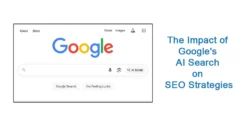The rise of AI-driven search features, such as Google’s AI Overviews and AI Mode, has fundamentally changed how users interact with online information. By delivering concise, AI-generated summaries at the top of search results, these tools provide quick answers, often eliminating the need to visit original sources. While this enhances user convenience, it has sparked alarm among news publishers and bloggers, who are seeing significant declines in website traffic. The shift threatens the sustainability of content-driven industries, forcing creators to rethink their strategies in an AI-dominated digital landscape.
This transformation is particularly acute for news outlets and blogs that rely on search engine referrals for audience reach and revenue. Studies indicate that AI summaries can reduce traffic to top-ranked sites by up to 79%, raising concerns about the future of journalism and independent blogging. This article examines the impact of AI search on news publishers and bloggers, drawing on recent data, industry reactions, and strategies for adaptation to navigate this evolving environment.
The Impact on News Traffic
AI-powered search features are significantly altering the traffic dynamics for news websites. A study by Authoritas, cited in The Guardian, found that websites previously ranked first in search results could lose up to 79% of their traffic if their links appear below Google’s AI Overviews. These summaries often provide comprehensive answers, reducing the need for users to visit the original news articles. Similarly, a Pew Research Center analysis reported that users clicked on links under AI summaries only 1% of the time, a stark contrast to traditional search results. MailOnline further corroborated this, noting a 56.1% drop in click-through rates (CTRs) on desktop and 48.2% on mobile devices due to AI summaries.
The broader implications for the news industry are profound. The Atlantic reported that Google’s AI Overviews have already reduced traffic to external websites by more than 34%, with some publishers preparing for a “Google Zero” scenario where search engine traffic could vanish entirely. This has contributed to layoffs at outlets like Business Insider and The Daily Dot, with industry insiders attributing these challenges to AI-driven search features. For news organizations reliant on search referrals, this trend poses an existential threat, as reduced traffic directly impacts advertising revenue and audience reach.
| Study/Analysis | Findings | Source/Comment |
|---|---|---|
| Authoritas analytics company | Sites ranked first could lose 79% traffic if results appear below AI overview | Submitted to UK’s competition watchdog, Google called it “inaccurate and based on flawed assumptions and analysis” |
| Pew Research Center | Users clicked a link under AI summary once every 100 times (1% click-through rate) | Google said study used “flawed methodology and skewed queryset” |
| MailOnline (Carly Steven, May) | Click-through rates dropped by 56.1% on desktop, 48.2% on mobiles | Reported impact of AI summaries on search results |
The Impact on Blog Traffic
Blogs, which often rely heavily on organic search traffic, are also grappling with the effects of AI search. A study by Neil Patel found that organic clicks have dropped by 2.23% since the rollout of Google’s AI Overviews. While blogs included in AI Overviews may see a traffic boost—such as Keyword.com’s guide to keyword tracking—those not featured often experience reduced visibility. This is because AI summaries frequently answer user queries comprehensively, reducing the incentive to visit individual blog posts.
Moreover, 52% of sources cited in AI Overviews rank on Google’s first page, meaning blogs on subsequent pages face even steeper declines in CTRs. This shift has led bloggers to question the effectiveness of traditional SEO strategies, as even top-ranked content may struggle to attract clicks when overshadowed by AI summaries. For example, niche or complex queries, such as “How to fix a leaking sink in an RV?” or “Best techniques for making hand-carved wooden spoons,” may not trigger AI Overviews, offering some hope for specialized content creators.
| Impact Area | Details |
|---|---|
| Effect on Click-Through Rates | Organic clicks dropped by 2.23% since AI Overviews rollout AI Overviews get 38.9% CTR |
| Traffic Boost if Included | Blogs included in AI Overview snapshots have a higher chance of clicks |
| Traffic Loss if Not Included | AI Overviews answering queries completely reduce clicks to individual sites |
| Ranking Impact | 52% of AI Overview sources rank on Google’s page one; page two+ results see lower CTRs |
Google’s Perspective
Google presents a contrasting view, emphasizing that AI-driven search enhances user experience and can benefit content creators. In its blog posts, Google highlights that features like AI Overviews and AI Mode provide faster, more comprehensive answers, enabling users to explore topics in depth. The company claims these features drive more engaged traffic to websites by highlighting relevant content and providing links for users to “dive deeper”. Google’s Shopping Graph, with over 35 billion product listings refreshed hourly, exemplifies how AI can deliver up-to-date information while directing users to external sources.
Google also provides guidance for content creators to thrive in this new landscape. Key recommendations include creating unique, high-quality content that AI cannot easily summarize, ensuring a seamless page experience with fast loading times and easy navigation, and using structured data to enhance visibility in AI results. Additionally, Google suggests focusing on the quality of visits rather than sheer click volume, noting that users arriving via AI Overviews may spend more time engaging with content.
Industry Reaction
The news and blogging industries have reacted with alarm and urgency. Many publishers feel “betrayed” by Google’s shift to AI-driven search, as reported by Bloomberg, with some experiencing traffic drops of over 70%. Social media discussions on platforms like X reflect this sentiment, with posts citing the Authoritas study and warning of a “devastating” impact on news audiences. For instance, @MorePerfectUS noted that Big Tech’s AI rollout is further reducing clicks to articles, exacerbating challenges for journalism. Another post referenced an Economist report claiming a 15% overall decline in search traffic, with health-related searches dropping by over 40%.
Despite these challenges, some publishers are proactively adapting. In our earlier post exploring how Google’s AI search is revolutionizing SEO strategies, offering insights on enhancing visibility in an AI-driven landscape. This reflects a broader trend of content creators seeking to navigate the new reality by rethinking their approach to content creation and audience engagement.
Adaptation Strategies
To mitigate the impact of AI search, content creators are adopting several strategies:
- Creating Unique Content: Publishers are focusing on in-depth, niche-specific content that requires users to visit the original source for full understanding. This includes detailed analyses, personal narratives, or specialized guides that AI cannot easily replicate.
- Optimizing for AI Search: Using structured data, high-quality images, and videos can improve a site’s chances of being featured in AI Overviews. Ensuring websites are crawlable and indexable by Googlebot is also critical.
- Enhancing Page Experience: Fast-loading, user-friendly websites with clear navigation are more likely to retain visitors, even if traffic decreases.
- Diversifying Traffic Sources: Publishers are exploring alternatives like direct subscriptions, social media, and newsletters to reduce reliance on search engine traffic.
- Focusing on Engagement: Google advises measuring success through engagement metrics like time spent on site, signups, or conversions, rather than just clicks.
Specialized publishers with dedicated audiences or subscription models may be less vulnerable than those relying on general-interest readers from search engines. Tools like Keyword.com and Google Search Console can help track AI-driven traffic changes and optimize content accordingly.
Conclusion
AI-driven search is transforming the digital landscape, offering users faster and more informative results while posing significant challenges for news publishers and bloggers. With traffic drops of up to 79% for news sites and 2.23% for blogs, publishers face an uncertain future. Google’s assurances that AI can drive engaged traffic are met with skepticism, as studies and industry reactions highlight the severe impact on click-through rates.
To survive, content creators must adapt by producing unique, high-quality content, optimizing for AI search features, and diversifying traffic sources. While the road ahead is challenging, those who innovate and embrace new strategies may find opportunities to thrive in this AI-driven era. The news and blogging industries stand at a crossroads, with adaptation being the key to sustaining their relevance and viability.







